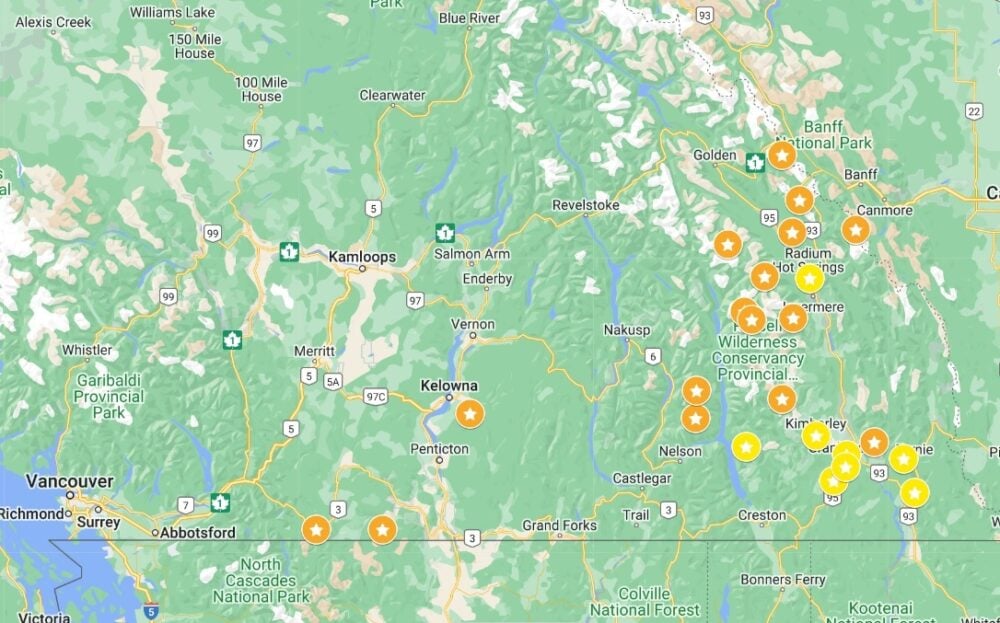The mountains of British Columbia become even more breathtaking in autumn when a golden glow appears in the alpine meadows.
This magical display of colour is provided by larch trees, which turn a vibrant yellow before shedding their needles for the winter.
While finding information on larch season on the Alberta side of the Rockies is easy, there are far fewer sources regarding where to see golden larches in British Columbia.

This post covers everything you need to know about larch season in British Columbia, including the best hikes to see golden larch trees, what to bring and when to plan a trip.
We have personally visited all of the featured BC larch destinations and many of them during golden larch season too! I love hiking in the alpine during golden larch season – temperatures are cooler, the scenery is beautiful and the air crisp.
Here’s what to expect in this post:
- What is a larch?
- Why larch are so special
- The best time to view larches in BC
- Alpine larch tree locations
- Western larch tree locations
- Essential tips for larch viewing
- What to bring hiking in larch season
- Golden larch FAQs
Larch season is fleeting – it disappears almost as quickly as it arrives. So be sure not to miss out! And always remember to Leave No Trace when exploring BC’s beautiful backcountry.
Last updated October 2024. This post includes some affiliate links. If you make a purchase via one of these links, we may receive a small percentage of the sale.

What is a larch?
Larches are a type of conifer tree. They feature soft, light green needle-like leaves dotted with seed cones.
Larch trees are deciduous, meaning that they lose their needles each year (unlike evergreen trees).
British Columbia is home to several types of larch trees, with the alpine larch, or Larix lyallii, being the focus of this post.
Alpine larch grows best at elevation (above 2000m) in cold, dry and rocky terrain. For this reason, alpine larch forests are pretty rare. The biggest concentration in British Columbia is found in and around the Rockies.

Due to slow growth, alpine larch trees may look small but are actually some of British Columbia’s oldest trees! Some sources claim that the larches in Manning Park as up to 2,000 years old.
The western larch, or Larix Occidentalis, is a taller version of the alpine larch. It prefers to live at lower elevations. The average Western larch is 500 to 1,000 years old.
Western larch is best spotted in BC’s Okanagan Valley and East Kootenay regions, specifically around Cranbrook and Kimberley in the latter.
British Columbia is home to a third type of larch as well – the Larix laricina, also known as the tamarack. These thrive in poorly drained, boggy soil and are found in most areas across Canada, from Yukon to Newfoundland (but not in southern BC!)

Why are larch trees so special?
Alpine, western and tamarack larch trees are some of the only coniferous, deciduous trees.
Despite having cones like evergreen trees, larch trees drop their needles every autumn. Before doing so, the needles turn from verdant green to a gorgeous golden colour for a short time.
With alpine larch trees being located in mountainous areas, the dramatic yellow colour of the needles provides a spectacular contrast against the snow-capped peaks.
Of course, the high alpine location also means that some hiking is usually required to see them.
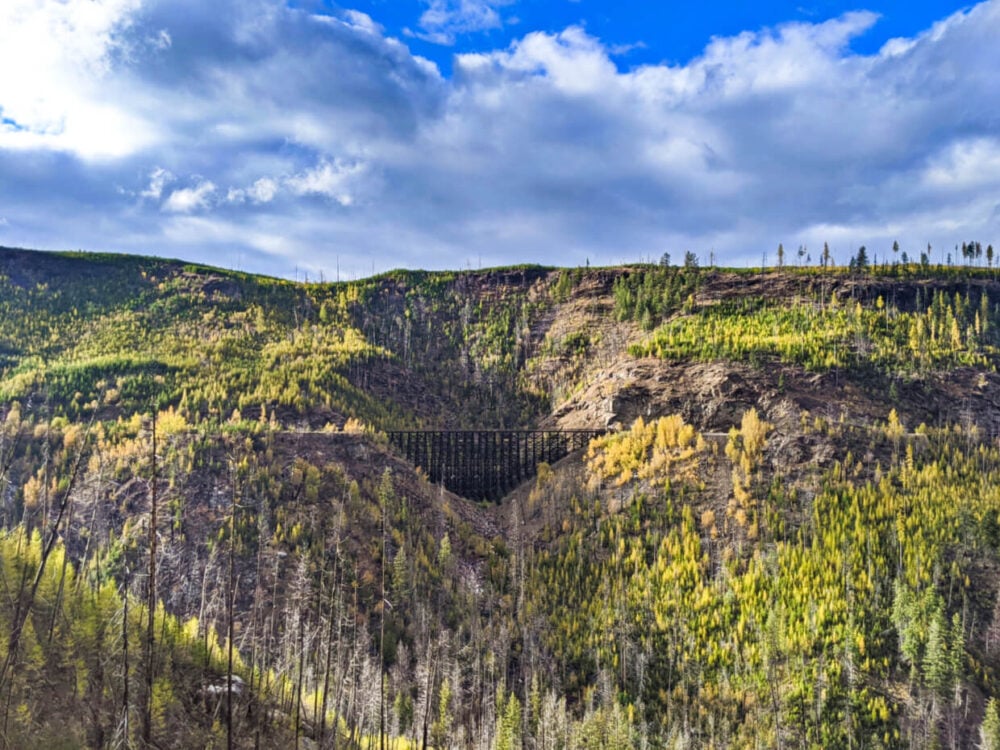
When is the best time to see larch trees in BC?
The best time to see the golden glory of British Columbia’s alpine larch is in early fall. There is usually a two-week window for the best colours.
Here are my recommendations as per location:
- Mid to late September for the Rockies
- Mid/late September to early October for surrounding mountain ranges (Selkirks, Purcells etc)*
- Mid to late September for Cathedral Provincial Park
- Late September to early October for Frosty Mountain
The exact timing of this golden peak varies from year to year and is highly dependent on weather conditions (specifically temperature).
Western larch trees turn golden a little later in autumn.
In the Okanagan Valley, the peak is usually from mid-October to late October. The timing is similar in the Kootenays but the colours can last into early November.

Alpine larch tree locations in British Columbia
The presence of many larch trees in the following locations guarantees a dazzling display of golden colours in fall.
We have personally visited each of the following ten destinations (and hiked the featured trails), although not always during golden larch season. Of course, I hope to rectify that shortly!
Please note that most of these locations are wilderness areas so you must be completely self-sufficient to visit (bring the 10 essentials!) and prepare for all weather conditions.
Be sure to Leave No Trace to ensure that other people, and generations to come, can enjoy the golden larch too.
If you’re not much of a hiker but still want to see the golden larches, I’d recommend scrolling down and reading more about Myra Canyon. In my opinion, it’s the most accessible place to hike and see golden larches in BC.
Frosty Mountain, E.C. Manning Provincial Park
Frosty Mountain in Manning Park is, by far, the most popular place to see alpine larch trees in British Columbia.
The reason is simple – Manning Park is the western limit for alpine larch trees in BC, making Frosty Mountain the closest larch destination to Vancouver (about three hours drive).

Convenience aside, Frosty Mountain is a spectacular larch viewing destination. The trail winds right through an expansive larch meadow, providing many different vantage points and photo opportunities.
The trail to access the meadow is, however, all uphill from the Lightning Lake Day Use Parking Lot. The climb is pretty steady but don’t underestimate it.
Adventurous hikers may want to continue past the meadow to Frosty’s panoramic summit via a rocky ridge ascent. The additional distance makes for a long day in the alpine, but the rewards are plentiful.
As well as the out-and-back hike as described below, it’s possible to hike this trail as a 27km loop via Windy Joe Mountain.
Mount Frosty Trail
Distance: 21km (8km one way to alpine larches)
Elevation gain: 1150m (800m to the alpine larches)
Hike type: Out and back
Time: 6-9 hours to summit and back (less to alpine larches)
Difficulty: Moderate to challenging
Camping: Frosty Creek Wilderness Camp at 7km
Fees: $5/per person/per night for backcountry camping
More details: Frosty Mountain Larches Hiking Guide

Cathedral Provincial Park
Despite being the second closest larch destination to Vancouver, Cathedral Provincial Park remains a little under the radar.
Situated at 2100m, the core area of this rocky park is the perfect growing environment for alpine larch.
Some golden hues can be seen around the lake campgrounds, but venturing further into the alpine will reveal even more impressive views.
The Rim Trail loop travels through several large strands of larch as it heads towards a number of unique geological formations, all backdropped by incredible mountain views.
There are two ways to access the core area of Cathedral Park – hike one of three strenuous trails (17km+) or take the Cathedral Lakes shuttle bus. To save energy, most hikers do the latter and camp for 1-3 nights.
September 2024 update – Cathedral Provincial Park is still closed after severe wildfire damage in 2023.
Rim Trail
Distance: 11km (12km with side trail to geological formations)
Elevation gain: 650m
Hike type: Loop
Time: 6 to 7 hours
Difficulty: Moderate
Camping: Quiniscoe Lake and Lake of the Woods
Fees: $10/per person/per night for camping
Dogs: Not permitted
More info: Rim Trail Hiking Guide

Monica Meadows near Kaslo
Monica Meadows is a relatively short hike with a huge payoff. It’s one of my favourite trails anywhere in British Columbia.
Although I haven’t yet visited Monica Meadows during larch season (we’ve always been a little too early!), I have heard that it hosts one of the most magnificent displays in all of British Columbia.
I can believe it too; the larch forest is extensive and backdropped by towering snow-capped mountains and immense glaciers. There are a number of pretty alpine lakes too.
The hike up to the meadows includes seven gruelling switchbacks, which climb 300m over the first 1.4km. The first larch trees are seen within the next kilometre.
The only ‘catch’ to this trail? The access. Prepare for 42km of gravel (high clearance recommended), with the final section being both steep and rocky.
Monica Meadows
Distance: 10km
Elevation gain: 650m
Hike type: Out and back with optional loop
Time: 4 to 5 hours
Difficulty: Moderate
Camping: Established campsite 2.6km from trailhead
Fees: None
Dogs: Permitted
More info: Monica Meadows Hiking Guide

Jumbo Pass near Kaslo
Heading to Monica Meadows this golden larch season? Put aside another day and hike up to Jumbo Pass as well. The trailhead is accessed via the same unpaved road north of Kaslo.
Like Monica Meadows, the hiking trail to Jumbo Pass is relatively short. With 800m elevation gain, it’s a bit of a workout but the scenery is well worth the effort.
The plateau at the top of the pass features a delicate meadow bordered by mountain peaks and larch trees. A steep path leads up to the top of a ridge, providing even better views of the surrounding summits and glaciers.
Already spectacular in summer, I can’t even imagine how incredible Jumbo Pass must look during larch season!
Jumbo Pass can be approached both from the east (near Invermere) and also from the west (near Kaslo). The details below cover the Western approach only.
Jumbo Pass
Distance: 10km return
Elevation gain: 800m
Hike type: Out and back
Time: 4 to 6 hours
Difficulty: Moderate, long ascent
Camping: At pass plus cabin rental
Fees: None
Dogs: Permitted
More info: Jumbo Pass Hiking Guide

Mount Assiniboine Provincial Park
The pyramidal-shaped peak of Mount Assiniboine is iconic at any time of the year but looks even better with a foreground of golden larch.
There are a number of beautiful viewpoints to view the golden larch in this 390.5 km² sized park.
The trail to Wonder Pass is lined with larch trees on the BC side, causing the landscape to light up in fall. It can be visited on the hike into Mount Assiniboine from Mount Shark or as a day trip from Magog Lake (campground, huts or lodge).
The Niblet, Nublet and Nub summits all provide excellent viewpoints as well, with alpine larch trees lining the turquoise lakes in front of Mount Assiniboine itself.
Mount Assiniboine Provincial Park is accessible only via foot, horse or helicopter. If you’d like to visit during the larch season, a little planning is required. Click the linked guide below for more info.
Magog Lake to Wonder Pass*
Distance: 6.5km
Elevation gain: 220m
Hike type: Out and back
Time: 2 hours
Difficulty: Moderate to challenging
Camping: Magog Lake, Og Lake, Mitchell Meadows, Naiset cabins
Fees: $10/per person/per night for camping, $20/pp/pn for cabin
Dogs: Permitted on leash
More info: Mount Assiniboine Hiking Guide
*As part of a Mount Assiniboine backpacking (or lodge) trip, not a vehicle-accessible day hike
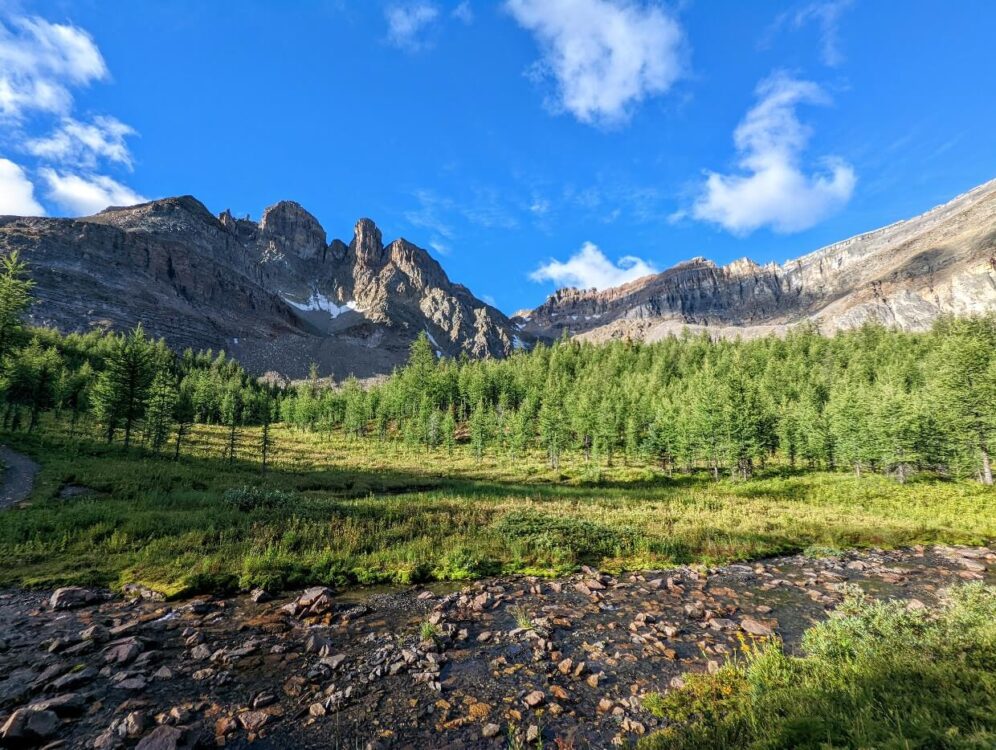
Floe Lake and the Rockwall Trail, Kootenay National Park
The Rockwall is a 54km long backpacking trail in Kootenay National Park, named as such for its proximity to a towering limestone cliff.
In fall, the trail becomes even more impressive as the larch forests surrounding significant parts of the route turn golden.
Backpacking the Rockwall Trail in mid to late September is undoubtedly beautiful but can be challenging. Expect snow, accompanied by freezing temperatures.
If hiking the entire Rockwall Trail isn’t an option, consider a long day trip or a quick overnighter to Floe Lake (details below).
A short hike beyond the waterfront campground reveals gorgeous views of the turquoise lake, framed by golden larch in the foreground and backdropped by massive mountains.
Reservations can be hard to secure for Floe Lake and the Rockwall in general, but cancellations are relatively common at this time of year (regularly check the Parks Canada Reservation System or use CampNab).
Floe Lake Trail
Distance: 24km return (21km to lake)
Elevation gain: 1300m (1110m to lake)
Hike type: Out and back
Time: 7 to 10 hours
Difficulty: Challenging
Camping: Floe Lake (reservation required)
Fees: $10.50/per adult admission fee plus $10.50/per person/per night for camping
Dogs: Permitted on leash
More info: Floe Lake Hiking Guide

Diana Lake near Radium Hot Springs
If you can only do one golden larch hike in the Radium Hot Springs area, choose Diana Lake. This relatively straightforward trail leads to a pretty turquoise lake in the Brisco range of mountains.
While the lake is lovely in its own right, the experience is taken to the next level by the sheer amount of surrounding larch trees. Indeed, Diana Lake’s expansive larch meadow feels almost endless!
The distance listed below is to the lake only, but I’d recommend walking at least a little further to see the full extent of the meadow.
There is a 1.5km loop trail that winds first along the lakeshore and then through the forest to Diana Lake Lodge (or vice versa). Stop in at the Lodge for some tea or a sweet treat.
An even better, but more difficult, hike would be to continue up to the ridge behind the forest and even scramble up to the 2752m high summit of the Judge. The views of the larch are sure to be incredible.
The unpaved road to the Diana Lake trailhead is usually in decent shape. Driving time from Radium Hot Springs is around 40 to 50 minutes.
Diana Lake Trail
Distance: 12km return, extra 2.2km (approx) to ridge
Elevation gain: 600m, extra 190m to ridge
Hike type: Out and back
Time: 4 to 6 hours
Difficulty: Moderate
Camping: Yes, small BC Rec Site
Fees: None
Dogs: Permitted on leash
More info: Columbia Valley Fall Guide

Conrad Kain Hut Trail, Bugaboo Provincial Park
Bugaboo Provincial Park is a legendary destination for rock climbers but it’s also an excellent spot to see golden larch trees in all their glory.
The hike up to the Conrad Kain Hut is not for the faint of heart, however.
Most of the total elevation gain is achieved in less than 3km, which makes the trail very steep. It often feels more like climbing stairs than hiking. There is a ladder and two sections with chains.
Near to the top, the trail reveals a rocky meadow with scattered larch trees. The views of the Bugaboos’ famous granite spires are spectacular.
If you have the time and energy, consider hiking an additional 1km beyond the Conrad Kain Hut to Applebee Dome Campground and the scenic alpine lake just beyond. There are no larch trees around the lake but it’s still impressive to see!
Plan for a full day of adventure to reach this BC golden larch location. The one-way drive from Radium Hot Springs takes around 75 minutes on unpaved roads.
Alternatively, plan to spend the night. There are two campgrounds here but during golden larch season, most overnight hikers book a spot in the well-equipped Conrad Kain Hut.
Conrad Kain Hut Trail
Distance: 10km return, extra 2km with Applebee Dome
Elevation gain: 700m, extra 255m to Applebee Dome
Hike type: Out and back
Time: 4 to 6 hours, 6 to 8 hours with Appledome Dome
Difficulty: Challenging
Camping: Yes, two campgrounds and cabin
Fees: $10/per person/per night for camping, $25/pp/pn for cabin
Dogs: Not permitted
More info: Conrad Kain Hut Trail guide

Welsh Lakes near Radium Hot Springs
Looking for another beautiful larch hike near Radium Hot Springs? Welsh Lakes is a great choice. This relatively rewarding hike climbs up a rocky bowl up to a stunningly turquoise alpine lake lined by larch trees.
Most of the trail’s elevation is gained in the last 1.6km so prepare for a steep ascent on talus and boulders. There are some pretty sharp switchbacks too.
Once at the Lower Welsh Lake, there is a rougher route that winds above the lakeshore to the newly established backcountry campground. Hikers with off-trail navigation experience can continue to more alpine lakes.
It took us 80 minutes to drive to the Welsh Lakes trailhead from Radium Hot Springs (39km total). Most of the route is on unpaved Forest Service Roads, though the first 21km or so is pretty well maintained.
From there, the road becomes more narrow and more potholey. I’d suggest using a vehicle with high clearance and good tires.
The final 1.5km of the road is very rough and there is no space to turn around. There is room for 2/3 vehicles to park at the start of this section – if you don’t have an appropriate vehicle, plan to hike it instead.
Welsh Lakes Trail
Distance: 8km return
Elevation gain: 500m
Hike type: Out and back
Time: 3 to 5 hours
Difficulty: Moderate
Camping: Yes
Fees: None
Dogs: Permitted on leash
More info: Columbia Valley Fall Guide

Lake O’Hara, Yoho National Park
Lake O’Hara is a hiker’s paradise and this is especially true during larch season. Access is pretty strictly controlled to this area, so you’ll need to plan ahead or prepare for a long 22km+ day hike just to the lake.
One of the best places to view the alpine larches at Lake O’Hara is from the Opabin Prospect viewpoint.
The vibrant turquoise colours of Lake O’Hara and neighbouring Mary Lake provide an excellent contrast with the golden trees. The entire Opabin Plateau is scattered with larch too.
Unsurprisingly, the Big Larch Trail (on the way to Lake McArthur) is another great spot to see alpine larch.
Our favourite place to see alpine larch at Lake O’Hara is the Odaray Grandview. The catch is, access is limited to four hiking groups to limit wildlife disturbance. So be sure to arrive early in the day.
Securing a campsite at Lake O’Hara is fiercely competitive. Reservations open in January for the entire camping season (late June to early October).
Keep an eye out for cancellations on the Parks Canada Reservation System or set up a CampNab scan.
It is possible to visit Lake O’Hara as a day trip as well. Every spring, there is a lottery ticket system for the shuttle. If you don’t manage to secure a seat, it is feasible to hike 11km in and either bus or hike out.
Opabin Plateau Circuit via the Opabin Prospect*
Distance: 5.9km
Elevation gain: 250m
Hike type: Loop
Time: 2 to 4 hours
Difficulty: Easy to moderate
Camping: Lake O’Hara Campground (reservation required)
Fees: $10.50/per adult admission fee plus $10.50/per person/per night for camping
Dogs: Permitted on leash (but not in the campground or on the bus)
More info: Lake O’Hara Hiking and Camping Guide
*Please note that the trailhead is not accessible by vehicle. See details above

Other places to see alpine larch in British Columbia
While the above locations provide excellent opportunities to see alpine larch in the fall, here are some other destinations to consider:
- Kokanee Glacier Provincial Park near Nelson
- Carpenter Pass near Kaslo
- Saint Mary’s Alpine Provincial Park near Kimberley
- Tanglefoot Lake near Cranbrook
- Brewer Lakes near Fairmont Hot Springs
Please note that some of these locations are very remote and require a 4X4 to access.

Western larch tree locations in British Columbia
Did you miss the window for the alpine larch season in British Columbia? Or just can’t get enough of the golden larches?
Head to the Okanagan Valley or the East Kootenays!
Myra Canyon near Kelowna
In addition to being one of the lowest elevation locations to view larches close to Vancouver, Myra Canyon is also one of the most accessible.
The Kettle Valley Rail (KVR) Trail runs right through the canyon, providing a completely flat path for hikers and cyclists.
This section of the KVR features 18 wooden trestle bridges, some up to up to 220m in length. It’s all backdropped by far-reaching views of Kelowna and Okanagan Lake.
Western larch trees line several sections of the trail, complementing the historic trestles with a pop of colour in autumn. Plan your trip for mid to late October to see them at their best.
I recommend hikers start at the Myra Station parking lot as there are more trestles close to this trailhead. The best larch forest is close to Trestle 7, at the 5km mark (see details below).
Myra Canyon Trestles
Distance: 10km return (recommended)
Elevation gain: None
Hike type: Out and back
Time: 2.5 to 3 hours
Difficulty: Very easy, wheelchair accessible
Camping: None
Fees: None
Dogs: Permitted on leash
More info: Myra Canyon Trestles Guide

Other places to see western larch in British Columbia
Check out these other beautiful western larch tree locations from mid-October to mid November:
- Gray Creek Pass near Crawford Bay
- Moyie Lake Provincial Park near Cranbrook
- South Star Recreation Area near Cranbrook
- Cranbrook Community Forest
- Kimberley Nature Park
- Silver Spring Lakes near Elko
- Tamarack Trail (Island Lake Lodge) near Fernie
- Valley View Lookout, Radium Hot Springs
Western Larch trees are taller than their Alpine cousins and are also more triangular.
Since this type of larch grows at lower elevations, they are generally easier to find as well.
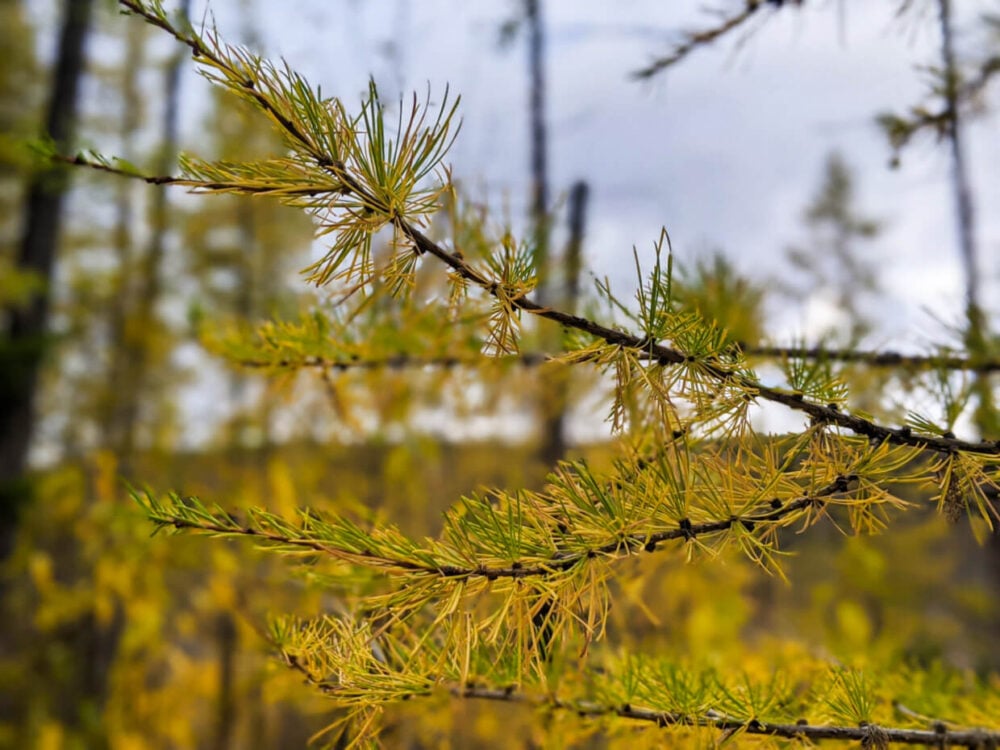
Larch viewing tips
- Keep an eye on social media. Use Facebook and Instagram to check the status of the larch colours in your chosen destination
- Plan to arrive early. Popular larch trails can get very busy. The earlier you go, the less crowded the trail (and the parking lot) will be
- Visit on a weekday. Saturday is the most popular day to hike larch trails, followed by Sunday
- Stay on the trail. Alpine areas are exceptionally vulnerable to damage
- Camp in designated areas only. Do not camp in larch meadows
- Never expect to have a phone signal in alpine areas. Tell someone where you’re going and when you plan to be back
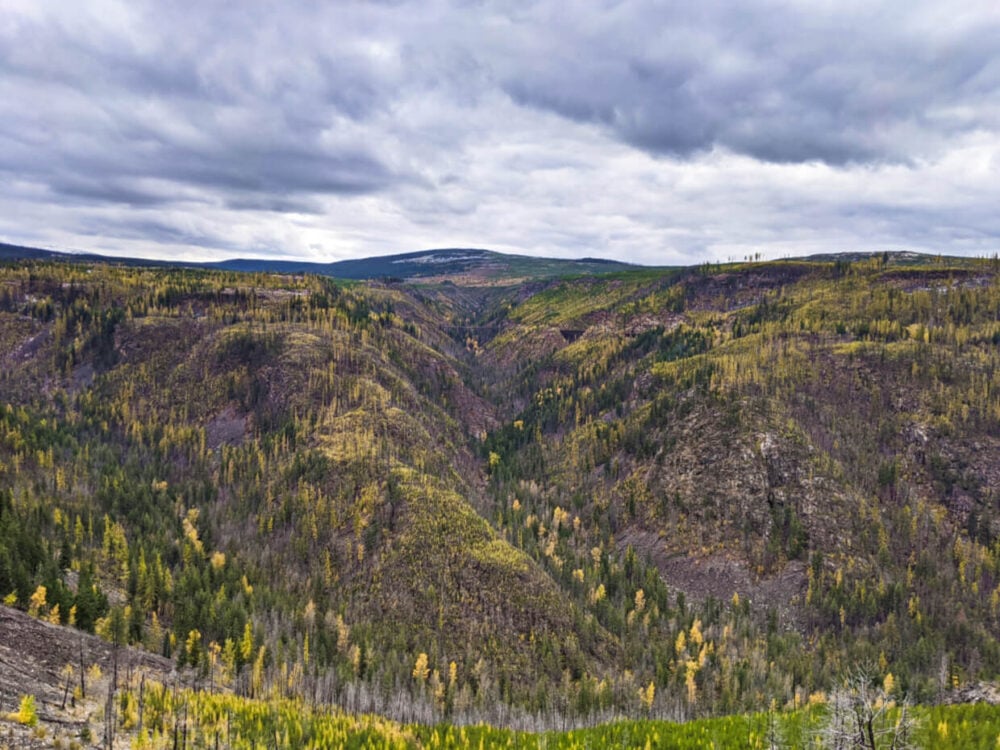
What to bring hiking in larch season
The weather can change quickly in the alpine so it’s crucial to bring appropriate clothing and gear.
Even if the conditions look favourable in the parking lot, the situation can be very different at higher elevations.
This is particularly true during the larch season when winter weather is possible. For this reason, bring clothing suitable for warm and cold weather.
This includes (but is not limited to):
- Multiple warm layers (I recommend merino wool)
- Insulated jacket (down or synthetic)
- Waterproof jacket
- Gloves
- Warm hat
- Scarf/Buff
- Micro-spikes for better traction on snowy/icy paths
Always bring the 10 essentials, to ensure that small inconveniences don’t develop into true emergencies.
Negative bear encounters are rare in BC, but having bear spray is the ideal ‘just in case’ measure. Carry it in an accessible place (a holster works well) and learn how to use it quickly.
The descents on some of these trails are long. Hiking poles help relieve pressure on the knees when descending. Incredibly light and foldable, Black Diamond’s Carbon Z poles are our tried and tested favourite pair.
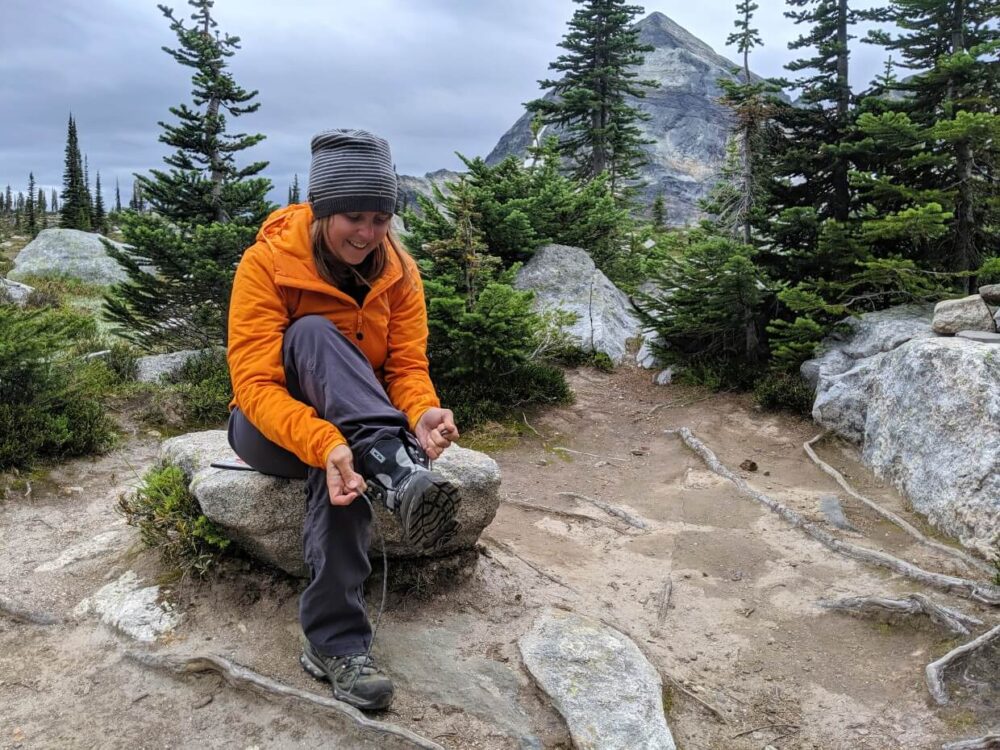
Golden larch FAQs
To finish, I’ll answer some of the most frequently asked questions about viewing golden larches in British Columbia.
Where are the closest larches to Vancouver?
Alpine larches prefer a cold, dry climate and therefore do not thrive in the Lower Mainland area.
The most accessible place close to Vancouver and the Lower Mainland to view golden larches is Manning Park, specifically on the Frosty Mountain hike.
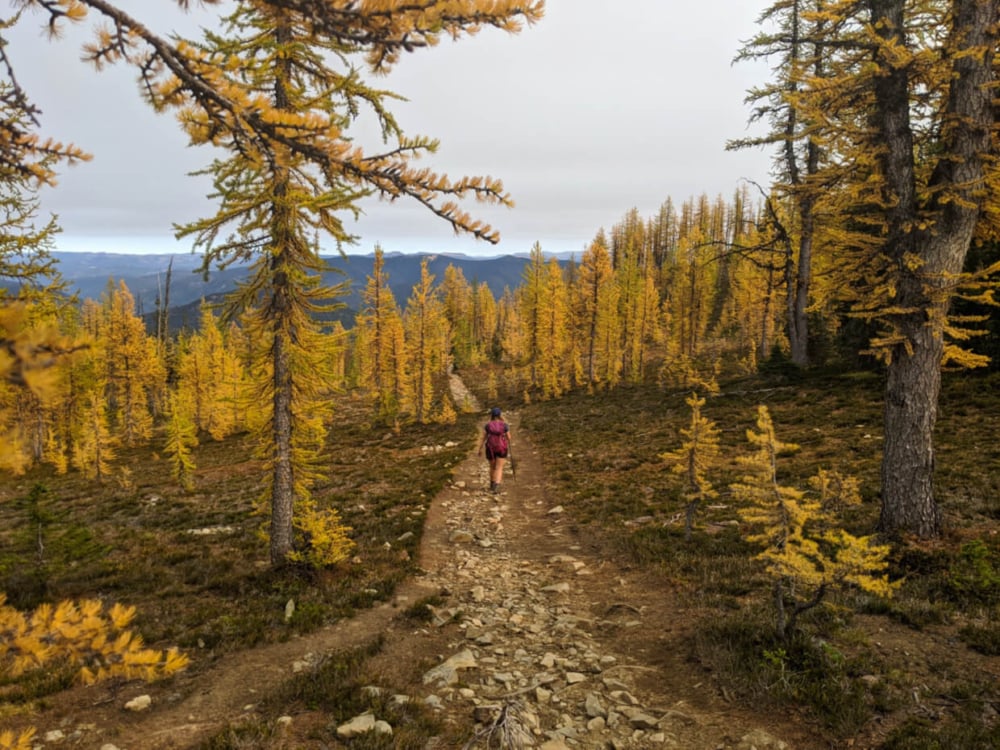
When will the larches peak in colour?
That’s a hard question with no specific answer; Mother Nature works on her own schedule! The timing of the peak varies each year and depends on the weather.
The time frames given in this post are an average, but if temperatures are warm, the peak could be later. If the weather is cold, the peak could be slightly earlier. It’s super variable.
How will I know when the larches approach the peak?
Keep an eye on social media. Facebook groups such as Hiking British Columbia are a valuable resource.
Trail reports on AllTrails are also useful. Likewise, Instagram, but keep in mind that not all users post recent photos.
Manning Park Resort usually posts some updates on Facebook regarding the status of the larches on Frosty Mountain and encourages hikers to use the hashtag #ManningParkLarches.
How long do the larches stay golden for?
Larch season is short in British Columbia, with most larches only staying golden for around two weeks.
But again, this depends on the weather. The larch trees may drop their needles sooner if temperatures are particularly cold.

Related posts you may find helpful:
BC in Fall: Our Top 10 Travel Destinations
13 of the Best Shoulder Season Backpacking Trips in BC
Backpacking 101: A Beginner’s Guide to Overnight Hiking
Where to Find Big Trees on Vancouver Island, British Columbia
The Great Divide Trail: Canada’s Most Epic Thru Hike
Backpacking Gear List: Packing Guide for Multi-Day Hikes
How to Reserve Backcountry Camping in BC: Essential Details and Dates
The Heather Trail, Manning Park: Complete Hiking Guide

One half of the Canadian/British couple behind Off Track Travel, Gemma is happiest when hiking on the trail or planning the next big travel adventure. JR and Gemma are currently based in the beautiful Okanagan Valley, British Columbia, Canada. Consider buying us a coffee if you have find any of our guides helpful!

